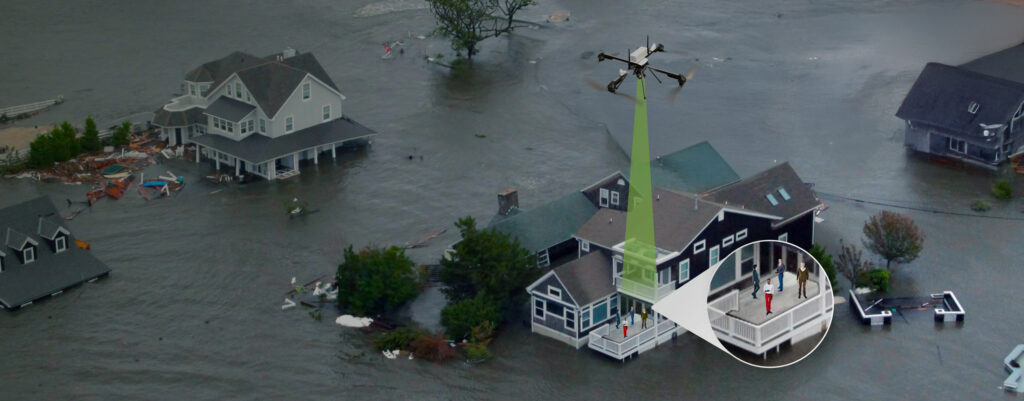
By integrating unmanned aerial vehicles (UAVs) into search and rescue operations, thousands of lives are saved annually. When a disaster strikes, every second counts, and having eyes in the sky can make all the difference. The introduction of UAVs into SAR protocols is a massive technological upgrade and a fundamental shift from relying primarily on traditional methods, which often fell short.
While traditional methods use human intelligence and reasoning, they have several limitations. Ground teams can only cover limited space and are not as fast as aerial vehicles. That said, helicopters do offer an edge over ground staff, but they’re very costly and require highly technical staff to operate. They both struggle with visibility in challenging terrain. While human responders cannot be replaced, these flying assistants drastically reduce the time and risk of locating survivors.
The introduction of sophisticated systems like thermal imaging capabilities, AI-powered detection algorithms, and extended flight times has optimized rescue operations’ overall efficiency and offered a better return on investment.
How UAVs Enhance Search and Rescue Operations
Time is the most critical factor in search and rescue missions, and the success of UAVs relies on the core strength of rapid deployment. An unmanned aircraft system (UAS) can be deployed within minutes, and it can cover a vast area quickly while doing so on foot might take a few hours.
Once airborne, UAVs use advanced technologies like thermal sensors to locate heat signals of lost or trapped survivors in heat or rubble.
Now that the damage is analyzed and survivors are located, the UAS emergency response system integrated with GPS and mapping software shares the exact coordinates with the ground operations to rescue the victims. This visual data also helps the ground team to create a safe evacuation path for the emergency support vehicles.
These technological innovations improve the accuracy and speed of search missions and empower responders with actionable insights that were previously not feasible.
Real-World Applications That Matter
Several state and federal departments in the United States have embraced this technology and use UAVs to locate hikers, surfers, and trekkers in regions where ground staff might take days to reach.
A recent case of a 10-year-old ATV rider stranded in a snowy Colorado wilderness who was rescued with the help of drones is a perfect example of how quick deployment of drones can make a massive difference.
During this mission, UAV was used not only to track the lost child quickly but also to communicate with the stranded boy using a speaker installed on the aerial vehicle. A care package of food, water, a winter hat, and a thermal blanket was also dropped using the drone till the rescue team arrived.
In a similar case, the thermal signature of the victim was traced using the UAV’s FLIR camera despite being hidden under dense pine coverage. In contrast, coastal operations have a different set of challenges. Maritime SAR relies on UAVs not only to locate distressed individuals but to deliver flotation devices or emergency supplies as well.
Such cases demonstrate how specialized technologies are helpful in specific rescue missions. These capabilities extend well beyond simple visual searches. Modern payloads include:
- Advanced thermal to detect human heat signatures from hundreds of meters, even through dense tree canopies
- Multispectral sensors to help identify disturbed vegetation or ground anomalies
- LiDar systems for real-time precise terrain mapping
- Automated flight patterns to ensure a comprehensive search
A successful search and rescue mission depends on using the right technology, timely deployment, and integration with existing protocols and personnel.
Addressing Challenges and Limitations in UAV Deployment
Even though deploying drones in SAR operations offers a distinct advantage, it requires finding a way through regulatory, technical, and environmental hurdles.
- Regulatory hurdles: These pose the most significant challenge. Any delay in licensing requirements or airspace restrictions can significantly delay the SAR operations. The FAA mandates most UAVs to operate within line-of-sight operation for most UAVs, impacting autonomous long-range missions. However, there are some exceptions for Beyond Visual Line of Sight (BVLOS) flights, especially for public safety use cases.
- Training needs: Operating high-end UAS platforms requires skill and proficiency. Acquiring relevant certifications is a time-consuming activity. Understanding search patterns, analyzing sensor data, and coordinating efforts with multiple teams required experience and practice.
- Weather: Inclement weather remains one of the biggest challenges in deploying UAVs. Heavy precipitation or strong winds may force UAVs to be grounded. Though advancements in making all-weather drones and improving stabilization are ongoing, newer drones can withstand adverse weather conditions.
Future of SAR – Autonomy and Integrations
The ongoing technological improvements offer a promising future for search and rescue operations. The development of Swarm technology, which includes several UAVs coordinating with the help of AI to carry out a blanket search operation in a large area and share real-time data, is poised to revolutionize SAR operations.
Integration of 5G technology is yet another emerging trend promising ultra-low data transmission latency. It will help drones to stream high-resolution visual and sensory data simultaneously. Similarly, enhanced battery technologies are assisting drones in remaining airborne longer, resulting in prolonged search operations.
Advanced AI algorithms offer AI-driven autonomy and predictive analytics to forecast survivor locations based on weather, terrain, and behavioral data.
Conclusion: A Strategic Imperative for Modern SAR
Integrating sophisticated and modern UAVs into search and rescue operations isn’t a promise for the future anymore. It’s a present reality helping save lives across the United States.
The benefits like speed, lower costs, and personnel safety put a strong case forward for deeper integrations of UAVs in SAR operations. Though challenges like weather, technical limitations, privacy, and regulations remain, UAV technology has earned its place in the search and rescue toolkit. It is setting new standards for emergency response effectiveness in the modern era.

